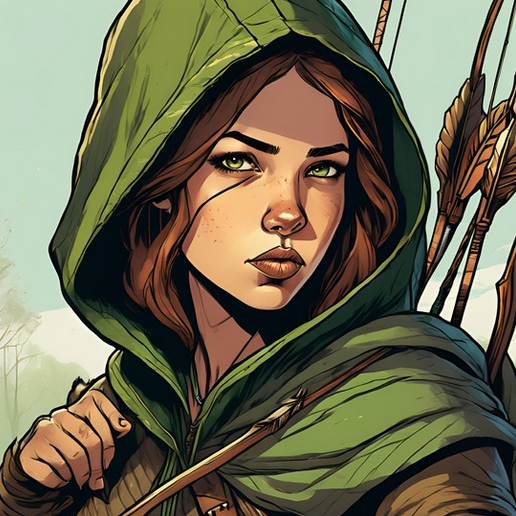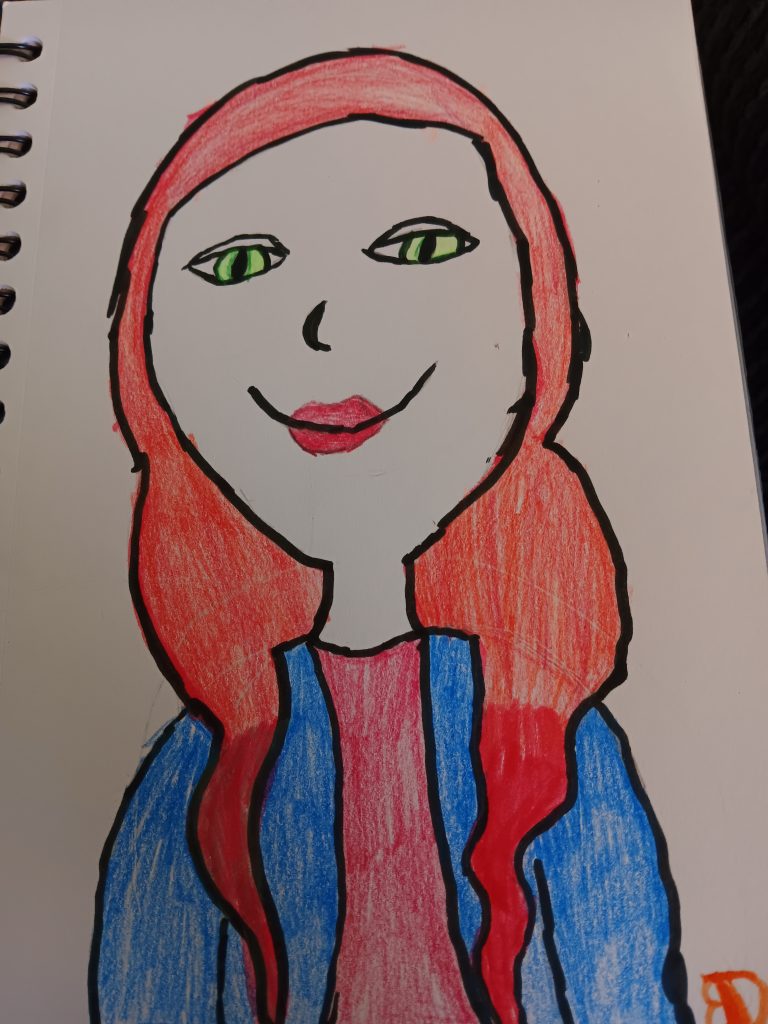Bella Johnson is a fourteen-year old writer who participated and completed the summer 204 Hero’s Journey Writing Challenge. Bella’s short story, “The Quest of Magic” tells of friendship found and lost with the sprinklings of magic present throughout the tale.
Read Bella’s epic short story below:

Splash! Went the water as I dived into the pool. I came up from the bottom and saw my two best friends waiting by the pool’s edge and Matilda looked sad so I swam over to them.
“Hey, what’s wrong Milly?”
“Her mom just called.”
“It’s no big deal,” sniffed Matilda
“Lue, can I speak to you for a minute?”
“Sure, Milly we will be right back,” as I was giving her a hug.
“What’s up Haz?”
Hold up, you’re probably confused about what is happening. My name is Lucille, I am 15 years old. I have brown hair, blue eyes and I have tan skin. My two best friends are Matilda, who goes by Milly and Hazel, who we only call Haz. Milly has blond hair with green eyes. Hazel has red hair with brown eyes. They both had lighter skin. Now that I have broken the Fourth wall let’s get back to real life importance.
“Milly, is having some… uh… family issues and she is trying to… deny her feelings.”
“Oh no, do you know what happened?”
“I don’t know. All her blood drained when she answered the call from her mother. Whatever her mom was saying was pretty bad.”
“Guys, we need to talk,” Milly whispered.
“Milly, is everything…” I started until we heard a scream.
I didn’t know who screamed but it seemed to be coming from the kiddy pool. We all ran in the direction to which the screaming was coming from. Once we got close enough the screaming died down and there was my brother and a little boy in his hands. He was talking to some of his lifeguard buddies he sometimes guards with. We got close enough to make out what they were saying.
“This boy needed help. I couldn’t watch it any longer.”
“He… touched my boy and… he…went out… COLD.” Sobbed the lady.
“Felix, what’s going on?”
“Sis, this is not a great time! We have to evacuate everyone before the manager…”
“Too late Felix, she’s already making her way over here as we speak.”
They went back to whispering and one of the lifeguards was trying to comfort the woman sobbing. We should really speed things up so while everything is happening while we wait for the manager my brother is actually my twin. He looks kinda like me but with brown eyes, not blue. Alright here we are with the manager.
“FELIX, what have you done?”
“This kid was struggling swimming and when I touched him he went out cold. We need to get air into him. I don’t know if he could last much longer in his condition.”
“Felix, why don’t you give him to me and I can start compressions.”
“Thanks sis. You’re a lifesaver.”
He handed over the kid to me and when I got him, he opened his eyes and looked around.
“Where am I? Mom! Mommy! Where are you?”
The sobbing lady looked around confused. The boy jumped from my arms and ran to his mother. When she turned around there he was. She looked so shocked that she fell back and started crying happily to have her son back.
“How… how… Did you do that?” said Hazel when I walked over there.
“I think what Hazel is saying is how did you heal that little boy right after you touched him.”
After Milly stopped talking I heard a mysterious voice. It started faint then got louder and louder.
“Sister… Sister… SISTER!”
“Lue, is everything alright. I want to know if you are ready to go home?”
“Yeah, I’m… I’m…”
What’s wrong with me? I thought. Why can’t I finish my sentence?
I tried to form words but no sound came out of my mouth.
“Lue, let’s get you home. I think you need to rest. Haz, let’s go.”
“Felix are you coming?” Shouts Hazel.
“You guys can go ahead and go. I will catch up.”
As we were walking I couldn’t help but notice that my friends were quiet. We are never quiet when we are together. I opened my mouth to make a sound. But I couldn’t hear anything.
“Milly, why don’t you tell Lue and me what is happening…”
We heard an explosion, it was coming from our neighborhood. Milly’s face drained from color. She was saying some words but we couldn’t hear over the sirens of firetrucks and ambulances. Milly started running and it took us a second to realize that she took off and we started to follow her.
We stopped short when we saw that Milly’s house was up in flames. We looked around frantically for Milly.
“Matilda! Matilda! Where are you?” Shouts Hazel.
“Matilda!” I shouted.
Yes, I thought. I can talk again.
Crash! The building started shaking and the roof was sliding off. Crash! The whole building started coming down. My vision was getting blurry and my eyes got prickly. What if Milly was in that building? My phone buzzed and I looked and saw a mystery text from a number.
We have your sister. The things that you need to do is get the venom of a giant spider, horn of a unicorn, tears of a siren. If you don’t complete these tasks in 4 days then you will never see her again.
As soon as I read the text, I turned around to run home. As I got home I saw no break in entry.
“Mandy! Mandy!” I shouted through the empty house.
“I’m here! I’m in Deliliah’s room.”
“Oh my… you’re both okay.”
I ran into Delilah’s room and saw them sitting on the floor reading books.
“Lucille! Lucille, are you okay?” Screamed Hazel.
I ran to Hazel tripping down the stairs. Hitting my head on the floor. Hazel screamed but I shushed her. I showed her the text.
“They must have Milly. We have to do it or we will never see her again.
“Lue, what should we do?”
We both started crying. I hesitated to tell her what I thought.
She noticed my hesitation right away.
“Milly is our friend! Why won’t you go?”
“I just don’t know if I am the right per…” the doorbell interrupted us.
We didn’t answer. We were afraid that it would be the police asking us what happened at the pool or what happened to Milly’s house.
“If you girls are not going to answer it I will.” shouts Felix.
“How did you get home? We live 5 minutes away.”
“I dunno, I just started running and I got here in 30 seconds.”
That’s weird! He must have… I pushed the thought away. I have enough to worry about with Milly gone and making sure her family is okay and know that Milly is gone. Oh no her family. What if her sisters and brothers were in the fire. No, they are resourceful kids. I heard Felix talking to someone. Wait Felix answered the door. I don’t remember him walking over to the door.
“I’m sorry sir. She is not up for company.”
“But I need to talk to both of you.”
“Our parents are not home. We aren’t allowed to let people in. So you can’t talk to us. Please leave our property or we will call the police. You have been warned.”
“I told you I need to come in and talk to both of you…”
I walked over to the door and saw an old man. He was wearing a green shirt with jeans with holes in them. He had white hair but he didn’t look like he was that old like he was in his 50’s. By this time Felix went into his older overprotective brother mode. Even though he is 15 minutes older than me.
“Felix, who is this man?”
“Lucille get back.”
I pushed my way through to the door. Felix started to call my name. I pushed the man over and I started running. I felt like time was slowing down. In no time at all I was in front of what used to be Milly’s house. Her younger brothers and sisters were out in the back.
“Lucille! Help us. We don’t know where our parents are.” said Gabe.
Gabe was Matilda’s younger brother. So that made him the oldest when Milly was away. Just thinking about her is making me so sad. He was holding Annastia and Beatrice the babies of the family. Annastia is only 2 and Beatrice is 4 months old. There was another kid running around named Payton and he is 5.
“Can you take Annastia for a minute?”
“Yeah, sure!” I took Annastia. “Do you guys need a place to stay while you wait for your parents? You’re more than welcome to wait at my house.”
“Yes please. Wait, where’s Matilda?”
“That’s the thing I guess I have to give you the story. It began at the pool…”
By the end we made it to my house. His face was so pale so I took Beatrice and made him go sit down. The old man was still at our house arguing with my brother. We made our way into the house and I got another text from the same number.
Looks like you’re not going to come easily. How about we told you we have your parents too? Would that change your mind?
I started getting dizzy and so many thoughts were running through my head. How did they know that I wasn’t going to do it? What do they want with my parents?
“Feli…” I started to yell but everything went black.
~~~~~~~~~~~~~~~~~~~~~~~~~~~~~~~~~~~~~~~~~~~~~~~~~~~~~~~~~~~~~~
I woke up in a room that I don’t remember going into. I felt something on my wrist. I tried to get up but I couldn’t. I was bound to a cold metal table. I started to scream.
“Stop screaming!” Said an Old man. “My name is Charles Kingsly, and I am a part of an organization that will help you get your family back.”
“Why am I like this?”
“Well I was talking to your brother and we heard you start to say his name and he turned and started running towards you. I heard him screaming and little kids crying. I came into your house and found you floating in your living room and saying stuff we could not understand. So I was wondering if you would like to join our organization and go and find your family.”
“What about my brother? Did he agree to join? I am not going to join if he is not present to help me make my decision.”
“Your brother is in the other room, he has already agreed to join only if you are okay with it.” He said something over his radio and Felix walked.
“Lucille, are you okay? You told me you would unbound her after she woke up.”
“My apologies.” He started undoing the bounds.
“So Lucille, do you think we should trust them? I mean I will only join if you want to join.”
“It’s okay! Felix, you don’t have to protect me. First we need to get our parents back and my best friend. Charles! I would like to join your organization.”
“So would I.”
“Excellent, I am glad that both of you are willing to join the organization. The first thing I must tell you is that I have been in this organization for a very long time and I am your mentor. I will be aiding you on this quest.”
A guy that we barely know is coming with us to find my best friend and my family. Not weird at all.
“We are leaving first thing tomorrow morning! Rest up, children, you’re going to need it!”
As soon as he left the room I got up and started walking around replaying the information I just got in my head again and again.
“ Lucille, do you think we should trust this guy and his organization?”
That stopped my pacing and I didn’t know who to trust. So I hesitated to answer Felix’s question.
Some random guys with white masks on came in and gave us cots to sleep on. We laid there and sleep didn’t come easy for me. Felix was out in a matter of minutes. I just kept thinking about how my life is just the worst. First my friend and now my parents. Oh my… I forgot to ask about my sisters. I hope they are okay. I suddenly felt a sharp pain in my leg and the world started to dim and everything went black
~~~~~~~~~~~~~~~~~~~~~~~~~~~~~~~~~~~~~~~~~~~~~~~~~~~~~~~~~~~~~~~~~~
I sat straight up. My hands felt something soft underneath it. I looked around the room. Strange. The room had pale blue walls and I was laying on a soft blanket. There was a backpack on a chair right next to the bed. My head felt like something was chewing on the inside of my brain. There was knocking at my door.
“Time to get up and find the unicorn to get its horn!” sang a voice through the door.
The old man walked into the room.
“Good morning, sunshine! I see you slept well. Here is some tea. We have a big day ahead of us. Felix went out with a friend of mine to go collect the spider venom this morning. They should be returning tonight.”
“Wait, Felix left this morning? What time is it?”
“Well… it’s 12 O’clock right now and your brother left at… 9.”
“Why didn’t anyone wake me up?”
“Well…we gave you a sleep draught and your body didn’t react the way we thought it would. Again you did the floating thing and we had to take you to another facility where you would be safe before the scientist started poking you. Then when we touched you, you went limp into our arms. No time for questions anymore we need to go find that unicorn!”
He went out of the room so then I could change. As soon as I got into some clothes I grabbed the backpack because it seemed important and went out the front door. We started walking and I saw that we just left a ranch style house. There were no other places for a 50 mile radius. What felt like a long time we finally made it to this really big garden and we saw bunches of unicorns. We had to be careful with which unicorn horn we needed to pick.
“Here is where we keep all our best unicorns and to harvest a horn you have to get to know a unicorn and it has to know you. If it knows the person and the person cares for them then they will be able to grow a new horn that is bigger and better than the one that was before. So I would suggest taking a medium size horn.”
“So no unicorn will get hurt right?”
“Yes, even if the person doesn’t care for the unicorn it will still be around but as a horse and it loses its magic forever. So I would suggest getting to know your unicorn before taking its horn.”
Hey Sis, Um… So we are having a little problem with the venomous spider, it bit one of the people and we started running…
“This is no time to be looking at your phone. We need to get the unicorn horn.”
“Right, sorry.’
I started walking over to the unicorns and the herd started moving away from me. I started speaking softly towards them telling them I am just a friend. One of the bigger unicorns decided to come over to me. I knew that I had a chance to try to bond with this creature.
Its beautiful brown eyes with silver specks with them were telling me something. It was like it was reading my soul and warning me about something. Then all of a sudden it fell to the ground and the unicorn started transforming. First the tail and then its body covered in oozing black goop then it reached its neck then its beautiful eyes until the gold horn was covered.
I heard screams and heard hooves reaching. Another big unicorn started charging at me. Like it wanted to fight. I understand that it wants its friend back but I have no way of bringing it back. I just kept getting closer and closer. I noticed at the last second I shot up into the air and was floating.
Wow! I didn’t know that I could do that. I thought. What else can I do?
My hands started to glow and my hands started heating up with all the power. I started to freak out. I didn’t know what was happening. I pushed my hands out and light shot through my hands. The unicorn jumped out of the way and started charging at me again but this time I was ready. I pushed the light a little bit just enough to direct the unicorn away from me.
It was surprised and it too started to run away. It wanted to get away and I wasn’t going to stop it. All the power that I had in me started to drain and I started falling from the sky. I landed on the ground with a hard thud. I laid there on the ground starting to sob. I didn’t get the unicorn horn and we only have 3 days left to find the supplies and get them to wherever they need to go.
“Are you alright Lucille?”
“Yeah, it’s just that I just realized that I might never get to see or hear from my family again if we don’t get the stuff we need.”
“Shhh! You’re alright!” He started to hug me but I pushed him away.
“I might never see my family again.” I cried
My phone started to buzz.
Hello Ms. Lucielle, I have bad news to tell you your brother was bitten by the spider and is getting rushed back to the house.
I curled up in a ball and started to cry
The old man just looked down at me with disgust. He opened his mouth to say something when we heard a scream. We ran towards the sound and we stopped and saw a girl fighting a griffin.
“Stop! You’re hurting it.” cried the old man.
“Well I am just trying to help my friend, when this griffin got in my way. The sirens are on the other side of this cliff.”
“Well… Hazel I thought I knew you better than this. The griffin would not attack people out of the blue unless they smell a bad aura around someone and I would have been notified if you had one.”
“Don’t be mad at Hazel. She must have accidentally stepped on the nest and it was defending the nest.”
“Yep! Absolutely! I was not looking where I was going and must have accidentally stepped on the nest.”
“Hmmmm!”
“Hazel! Have you heard about my brother?” She shook her head no. “My… brother… was bitten… by the spider.” I was practically sobbing at this point.
She came in for a hug and she and I started walking back to the house to check on my brother. When we got in the house we noticed that it was quieter than usual. Nobody greeted us and nobody to see if we needed anything. It’s like everyone was worried about my brother. We walked into Felix’s room and noticed right away that if they didn’t heal him he could die in the next couple of days. I broke down again not wanting to look at him. I started running towards his bed but somehow I couldn’t get there. It’s like his bed was protected by a force field. I looked at him and for the first time I looked at his hands, they were glowing a dark purple and I noticed that some of the purple was surrounding his bed.
My hands started feeling hot again and I looked down and saw that my hands were glowing a gold color. My head started spinning again and I tried to fight the force field and go to my brother.
“STOP!” A voice yelled. I ignored them. I felt something touch me but I didn’t react. “You’re only hurting him, his power is trying to protect him from you.” The voice was quiet and hard to hear like it was in my head.
I decided to stop trying to get to my brother.
Maybe I should stop on my story… This is a painful memory.
You want to know what happens next. Will my brother live, will I get my parents? Oh all right.
Next thing I know I feel a sharp pain in my arm and the world starts to go dim.
~~~~~~~~~~~~~~~~~~~~~~~~~~~~~~~~~~~~~~~~~~~~~~~~~~~~~~~~~~~~~~~~~~
Ugggg! They really need to stop drugging me. I woke up in my bedroom and I tried to get up but a huge creature was laying on me.
“Oh, good you’re up!” it said in a singsong voice.
“What are you?”
“Hahaha, you silly human.” It cocked its head. “You really don’t know what I am? Wow, do they not teach you in any of those… um… what’s the word I’m looking for?”
“School?”
“Yes! School! Do they not talk about sirens and how to find them or catch them and how they are just chatty creatures.”
“Ummm, no. We learn how you all like to sing a song and then you crash boats and start laughing and all the people on the boat die.”
“Hmmm, we don’t do that. Not even the mermaids. Well anyway, are you really the girl from the prophecy?” I shook my head. “Oh! I thought we found her! Has anyone disappeared recently?” I nodded my head. “Goody! That means you are the girl from the prophecy. You had people taken by other people and then you need venom of a giant spider, horn of a unicorn, tears of a siren. Correct.”
“Yes, but why are you here? Where’s my mentor?”
“Well, what has happened to your brother. I have to take over as your mentor and besides he can’t become your best friend. My name is Sea Shine! You can just call me Cece. The one thing is that where we are going is a place your magic can’t go. Sirens hate being beaten by humans when it comes to magic and most humans don’t have magic. When they do, they get mad at the humans and ban them from their home and hospitality forever.”
“Wait, I have magic?”
“Yes you and your brother both. You think it was a little weird that there was a purple force field around your brother or that somehow you heard my voice in your head that was faint. It’s magic. Your brother and you have the best magic that I have ever seen. Here I want you to wear this.” She handed me a necklace with a locket on it. “If you get over emotional it will help you control and channel your magic on one thing like that unicorn battle you had. I should have been with you to give you this but I went with your brother and let’s just say one thing it was not fun.”
“Really, I could get the unicorn horn again! I thought the unicorns hate me.”
“Well… I talked to them explaining the situation and they agreed to give up their horn under one condition. That you were that to show that you are doing the right thing and going to use your magic for the right thing.”
“Oh my gosh… Thank you. I want you to be my friend forever. I have one last thing to ask you Cece.”
“Name it kid whatever it is.”
“Can my friend Hazel come and see the world of sirens? She never believed that you all were as mean as the legend says.”
“All right but we are leaving first thing…
We heard knocking on the door. When we reached the door we saw a unicorn horn.
I tried to pick up the Unicorn horn but it was just a hologram.
“Hahahaha, you fell for the Unicorn trick. Don’t worry they do it to everyone that upsets them. I have upset a unicorn before and she started doing tricks on me and it was hilarious. Once we were friends again we laugh about it all the time.”
“Wait, Unicorns can transform into humans?”
“All magical things here can transform into something. It takes a lot of magic to do it so most of them stay the same. Some of the unicorns were actual humans and decided to become a Unicorn. They came on a similar quest as you and they decided that they wanted to stay here.”
“That’s so cool. I kinda want to go home with my family.”
Cece’s face fell. “Yeah, I guess you should go back home with your parents when we save them.” she sighed.
“I can still come back and hang out with you. And who knows maybe I could find a way to hang out here during the summer and you can show me your awesome swimming moves.”
“You’re right. That would be so cool.”
Hazel came bounding down the stairs in her running shoes. She looked like she was ready to change the world.”
“I am so glad you decided to come with us Haz. You’re the greatest!”
“Yeah the greatest.” Her face fell and she looked a little uncomfortable.
“Well let’s get going! If we don’t start now. We might not make it there before the light fades away.”
“WAIT!” Charles was running with something in his hand. “Take the venom we were able to extract from the bite. Then you can give it to them after you get the tear and horn.”
“My…”
Charles interrupted me. “We have him, he will be in good care while you’re gone. As you are there, learn how to use your magic.”
“Thank you for being an amazing mentor.” Cece was gesturing for me to follow. They must have started walking. “Goodbye Charles!”
I put the venom carefully in my backpack and we started. We walked into the woods. It seems quieter now that we are not running through the woods. Then I started to think that it was too quiet.
“Were nearly to the Unicorns!” Cece called. “We just need to get over this hill and…”
She stopped dead in her tracks. There was a figure dressed in all black just standing there. He had a hood up so I couldn’t tell who he was or what he looked like.
“Get out of the way!” Yelled Cece.
The hooded figure just started smiling. All I could see was his smile and it looked like he had fangs. Weird. He started walking toward us.
“Stop! Leave my friend out of this, Rarnib.”
“Why should I?” said a husky voice. “You were the one who wanted this job. Don’t you remember you were only 5 when we let you get this job and you did it. You finally brought the girl we need and… Where’s the brother? We need both twins of power.”
“Hazel, what is he talking about?”
“Rarnib, I already told you the brother could not come but she is just as strong. She might even be stronger than you with the proper training!” Hazel started smirking.
“Watch that tone with me, Synthesize.”
“I told Rarnib, my name is Hazel. I don’t go by that name anymore.”
“What! What have they done to our shapeshifter and the best of the best. You’ve gone soft, your “best friend” has made you soft.” He said it in air quotes.
“Hazel, what is he talking abo…”
“You!” He pointed at me. “You are coming with me. Your time is up, pretty thing. The only way to stop us is to fight me!”
He started summoning up some black cloud and it started coming right at me. I got hit by it. My hands started to get hot and sunlight started to come out of my hands. I started floating. I blacked out.
———————————————————————————————————————
Cece
She started to float. Lucille’s eyes turned white. She summoned a big ball of white energy and started throwing little chunks of the light at Rarbin. He kept dodging and he would always throw back his own magic back at her. I felt defenseless. She looks like she can stop him by herself. She doesn’t need me.
She hit him square in the chest and he fell back looking really scared. Hazel ran up to him and tried to protect him.
“Hazel, move out of the way.” Lucille said.
“No, you’re hurting him.”
“He took my parents and Milly, do you not care.”
“Yes I do care but I was the one who took everyone. I was the one to give the command and I am really sorry. I was just jealous at your and Milly’s friendship that I did a very bad thing and taking your parents was not right either. We just want your power to finish the invention we were making.”
“You mean an invention to destroy the world.”
“Yeah, that could be a side effect of us using the invention. We are trying to make a better world where people with magic don’t have to hide so Lue. What do you say? Will you join us?”
“Lucille, no don’t listen to them. They just want to get rid of the human race.”
“I’m sorry, my dear friend. I can’t trust you or your people.”
Lucille lifted up her hands and summoned the biggest light and she threw it. I had to turn away from the scene.The world went very bright and there was screaming. When the light died down there was gold dust flying around.
“I am so sorry, my dear friend,” whispered Lucille.
———————————————————————————————————————
Lucille
I woke up back in my room, with my brother by my side.
“You did it Lucille, you saved everyone!”
Milly and my family came in for a big group hug.
The End











